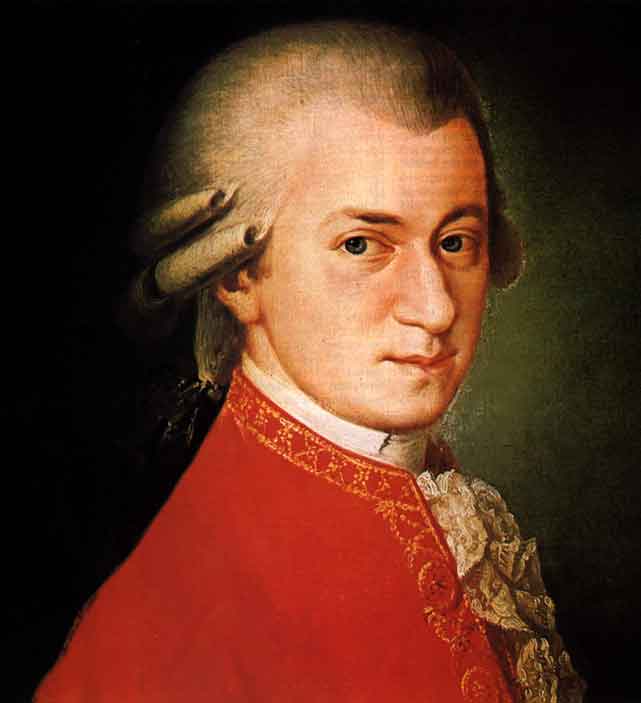Wolfgang Amadeus Mozart (1756-1791)
Born January 27, 1756 in Salzburg, Austria.
Died December 5, 1791 in Vienna.
Ballet Music from Idomeneo, Ré di Creta K. 367
Composed December 1780-Jan 1781 in Munich
First Performance: Jan 29, 1781 Residenztheater
Instrumentation: 2 flutes, 2 oboes, 2 clarinets, 2 bassoons, 2 horns, 2 trumpets, timpani, strings
In 1780 Karl (Charles) Theodor (1724-1799), Elector of Bavaria, commissioned Mozart for an opera to be performed during the Munich carnival season the following year. The Elector was a great lover of the arts. He assembled an orchestra at his court in Mannheim which produced many innovations by composers such as Stamitz that were influential in the development of the Viennese classical style. Mozart had actually previously applied for a position at Mannheim but was turned down. In 1777 Karl Theodor became Elector of Bavaria and moved to Munich.
Mozart’s new opera [amazon text=Idomeneo&asin=B000064691] was performed three times during the carnival season. It was performed only once more during Mozart’s lifetime when he revived it in 1786 for a concert performance in Vienna.
Mozart began the composition in October in Salzburg. In November he traveled to Munich to consult with the singers. He was finished with the opera by January, 1781 writing to his father “One cannot but be happy to be finally freed of such a great, laborious task.” He then began to write the ballet music with the premiere looming at the end of the month. He apologized to his father for not writing saying that “’Till now I’ve been busy with those cursed dances – Laus Deo – I have survived it all.”
The Salzburg Court Chaplain Giambattista Varesco adapted a French story Idomeneo by Danchet that André Campra had set in 1712 into Italian. The elector seems to have been pleased with the opera. Mozart quotes him as saying “No music has ever made such an impression on me. It is magnificent.” The choreographer was Jean-Pierre Le Grand, who was the ballet master at the Munich court.
The autograph copy of the score contains many cuts and revisions. It is not possible to determine which dances from the ballet music were actually performed at the premiere. The Passacaille is fragmentary and contains no build up of excitement so it is doubtful that Mozart would have ended with this piece. According to Daniel Heartz, the editor of Idomeneo for the Neue Mozart Ausgabe Sämtlicher Werke (NMA), the work ended with Pas seul de Mr. LeGrand. Heartz says that “it is really difficult to believe that Mozart intended to follow this triumphant ending in D by something else–certainly not by the dainty Passepied in Bb or the ethereal little Gavotte in G.” His view is that the Passepied, Gavotte, and Passacaille were cut from the first performance and the first two dances were placed at the end of the opera.
The individual dancers – Mad. Falgera, Mad. Hartig, Mr. Antoine – are indicated in the score. It appears that Mr. Le Grand reserved the best parts for himself.
For the [amazon text=Suite K.V. 367&asin=B000004116] we hear today the arrangement of the movements is:
1, Chaconne (Allegro, Larghetto, Allegro)
2. Pas seul (solo dance) de Mr. Le Grand (Largo, Allegretto, Più Allegro, Più Allegro)
3. Passapied pour Madsell. Redwen, Pas seul de Madsell. Redwen
4. Gavotte
The theme of the Chaconne was “borrowed” from the Chaconne in Gluck’s Iphigénie en Aulide. The entire corps danced at each return of the Chaconne’s rondo theme, and again in the closing più allegro.
The pomp of the chaconne theme is followed by a quietly meditative larghetto.
The next dance, entitled La Chaconne, qui reprend begins quietly but moving quickly in D minor.
Example 3. La Chaconne, qui reprend – Allegro

Then this bustle stops for the middle section Pas de Mme Hartig which features an oboe solo. The movement ends with a reprise of the Chaconne rondo theme
The Pas Seul de Mr. Le Grand also begins with much pomp.
Example 4. Pas Seul de Mr. Le Grand – Largo

Soon after a light allegretto featuring pairs of woodwinds brightens the mood which leads into a più allegro set of running string passages. Another più allegro featuring interesting rhythmic use of triplets with the arrival of the entire corps brings the dance to a brilliant conclusion.
The third movement consists of the fragmentary Passapied pour Mademoiselle Redwen which is followed by the Pas seul de Mademoiselle Redwen. The Passapied contains four 8 measure repeated sections and a da capo (play everything from the beginning). The Pas seul contains only two 8 measure repeated sections and also has a da capo.
The Final dance is a gavotte. In the NMA this appears in Act I as the Ballo delle donne Cretesi No. 8a. The overall form is a repeated first section A followed by a middle section B then closing with a return of the repeated A section. Mozart must have liked the theme from the A section because it reappears in the finale of his 1786 Piano Concerto K 503.
Resources
[amazon template=iframe image&asin=B000005E5N][amazon template=iframe image&asin=B0000041LF][amazon template=iframe image&asin=B000004116][amazon template=iframe image&asin=B000064691]



